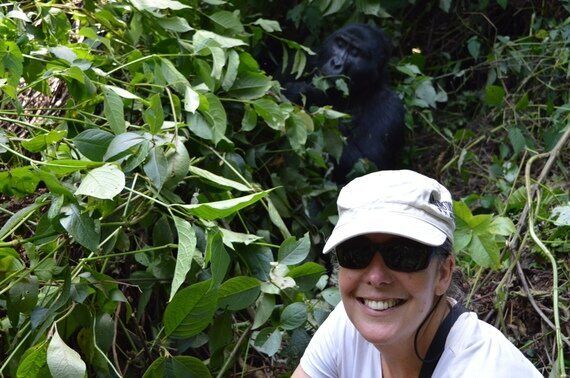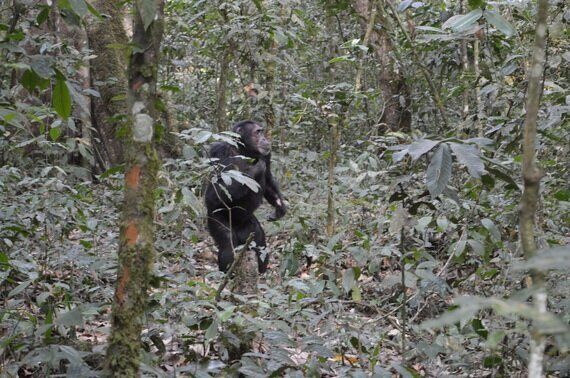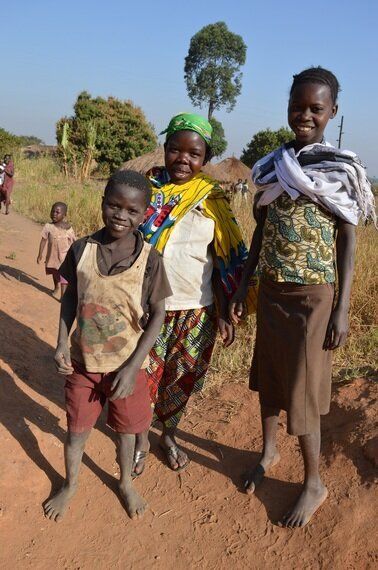
"He's behind you" and no, it's not someone in a gorilla suit but the ultimate selfie! I was with a group, gorilla tracking in Uganda. Not as simple as it sounds but involving an extremely challenging three hour trek in the Ruhija district of Bwindi Impenetrable (lives up to its name) forest. We were told we would be tracking the Oruzogo group, a family of 17 habituated gorillas. Little did we know that upon arrival this group of 17 gorillas would soon turn into 18. It is common for mother gorillas to hide a new-born for up to a week, but Nykeina (the mother) revealed her new-born to us just after it had been born at 11.16 am on the 17th January this year. We were the first people to see the baby, our accompanying rangers were astounded, they didn't even know Nykeina was pregnant and as there are less than 900 of these great apes left in the world, this birth was a real chance for a celebration.

Although, the baby was undoubtedly adorable, it was papa that got my attention, a massive silver back basking proudly in the sunshine. As in births the world over, the mother gently protected the baby as friends and family came to inspect the new addition, whilst the father was content to just sit back and share the glory. It was a privilege to be able to watch them at such close quarters for over an hour, before bush whacking back through the forest. Each of us had a porter (highly recommended) not so much to carry your bag but to hold your hand and prevent you from tripping up over the many vines and to push you and pull you up the steep, densely forested slopes. Seeing mountain gorillas in their natural habit, going about their daily routines is a truly unforgettable bucket list experience and one of the main reasons people visit Uganda.

However, hot on the heels, chimp trekking offers a different kind of reward. Uganda's Kibale Forest National Park has the greatest variety and concentration of primates found anywhere in Africa. There are are almost 1500 chimpanzees and with a community of 120 habituated chimps you can spend an adrenaline fueled hour with our closest relatives. They are highly mobile and active as they move around in their social groups, so keeping up with them is no mean feat. You hear the chimps before you see them, their distinctive cries (sounding rather like a group of young girls shrieking on a night out) can be heard throughout the forest. The trek to see the chimps was considerably less arduous, in fact the first cries were heard minutes into the trek and the chimps spotted soon afterwards, running along the ground, beating the tree trunks to communicate with one another and the alpha male, doing his best Donald Trump impersonation. Chimpanzee trekking in Kibale began in 1991 when the first family of chimpanzees had been successfully habituated to the presence of humans. Back then the chances of a sighting were less than 20% but it is now over 90% and another huge tick on any adventurers list.

Uganda's ten national parks contain a variety of habitats ranging from snow-capped mountain peaks and vast papyrus swamps to tropical forest and open savanna plains, home to an impressive range of wildlife. There's the usual big five along with giraffes, antelopes, hyenas, even tree climbing lions. Uganda is one one of the rare places where lions climb trees on a daily basis. They do this as a way of protecting themselves against the numerous biting tsetse flies on ground level and to escape from the the heat of the day. I was blown away by how our safari guide was able to spot said lions in a tree seemingly miles away from the road, what I thought was a branch was in fact the lion's tale. On this kind of trip, you do need a high powered zoom lens so sadly I was unable to capture this astonishing site, but it was perhaps the less photographed animals, a warthog with its babies - are they called hoglets? following it like something from a Disney cartoon that got the biggest smile from me.

Cows with impossibly large horns grabbed my attention more so than the ubiquitous Uganda cob (a type of antelope).

There were signs, open to misinterpretation "no antelopes jumping over rhinos" ?

And whilst I never tried of seeing children waving and joyously shouting "how are you" to our passing vehicle, it was getting to know my distant ape cousins that was the ultimate thrill.
All photos taken by Petra Shepherd
FOR MORE INFORMATION
To find out more about Uganda